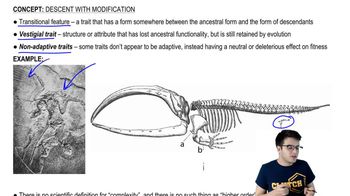Table of contents
- 1. Introduction to Biology2h 42m
- 2. Chemistry3h 40m
- 3. Water1h 26m
- 4. Biomolecules2h 23m
- 5. Cell Components2h 26m
- 6. The Membrane2h 31m
- 7. Energy and Metabolism2h 0m
- 8. Respiration2h 40m
- 9. Photosynthesis2h 49m
- 10. Cell Signaling59m
- 11. Cell Division2h 47m
- 12. Meiosis2h 0m
- 13. Mendelian Genetics4h 44m
- Introduction to Mendel's Experiments7m
- Genotype vs. Phenotype17m
- Punnett Squares13m
- Mendel's Experiments26m
- Mendel's Laws18m
- Monohybrid Crosses19m
- Test Crosses14m
- Dihybrid Crosses20m
- Punnett Square Probability26m
- Incomplete Dominance vs. Codominance20m
- Epistasis7m
- Non-Mendelian Genetics12m
- Pedigrees6m
- Autosomal Inheritance21m
- Sex-Linked Inheritance43m
- X-Inactivation9m
- 14. DNA Synthesis2h 27m
- 15. Gene Expression3h 20m
- 16. Regulation of Expression3h 31m
- Introduction to Regulation of Gene Expression13m
- Prokaryotic Gene Regulation via Operons27m
- The Lac Operon21m
- Glucose's Impact on Lac Operon25m
- The Trp Operon20m
- Review of the Lac Operon & Trp Operon11m
- Introduction to Eukaryotic Gene Regulation9m
- Eukaryotic Chromatin Modifications16m
- Eukaryotic Transcriptional Control22m
- Eukaryotic Post-Transcriptional Regulation28m
- Eukaryotic Post-Translational Regulation13m
- 17. Viruses37m
- 18. Biotechnology2h 58m
- 19. Genomics17m
- 20. Development1h 5m
- 21. Evolution3h 1m
- 22. Evolution of Populations3h 52m
- 23. Speciation1h 37m
- 24. History of Life on Earth2h 6m
- 25. Phylogeny2h 31m
- 26. Prokaryotes4h 59m
- 27. Protists1h 12m
- 28. Plants1h 22m
- 29. Fungi36m
- 30. Overview of Animals34m
- 31. Invertebrates1h 2m
- 32. Vertebrates50m
- 33. Plant Anatomy1h 3m
- 34. Vascular Plant Transport1h 2m
- 35. Soil37m
- 36. Plant Reproduction47m
- 37. Plant Sensation and Response1h 9m
- 38. Animal Form and Function1h 19m
- 39. Digestive System1h 10m
- 40. Circulatory System1h 57m
- 41. Immune System1h 12m
- 42. Osmoregulation and Excretion50m
- 43. Endocrine System1h 4m
- 44. Animal Reproduction1h 2m
- 45. Nervous System1h 55m
- 46. Sensory Systems46m
- 47. Muscle Systems23m
- 48. Ecology3h 11m
- Introduction to Ecology20m
- Biogeography14m
- Earth's Climate Patterns50m
- Introduction to Terrestrial Biomes10m
- Terrestrial Biomes: Near Equator13m
- Terrestrial Biomes: Temperate Regions10m
- Terrestrial Biomes: Northern Regions15m
- Introduction to Aquatic Biomes27m
- Freshwater Aquatic Biomes14m
- Marine Aquatic Biomes13m
- 49. Animal Behavior28m
- 50. Population Ecology3h 41m
- Introduction to Population Ecology28m
- Population Sampling Methods23m
- Life History12m
- Population Demography17m
- Factors Limiting Population Growth14m
- Introduction to Population Growth Models22m
- Linear Population Growth6m
- Exponential Population Growth29m
- Logistic Population Growth32m
- r/K Selection10m
- The Human Population22m
- 51. Community Ecology2h 46m
- Introduction to Community Ecology2m
- Introduction to Community Interactions9m
- Community Interactions: Competition (-/-)38m
- Community Interactions: Exploitation (+/-)23m
- Community Interactions: Mutualism (+/+) & Commensalism (+/0)9m
- Community Structure35m
- Community Dynamics26m
- Geographic Impact on Communities21m
- 52. Ecosystems2h 36m
- 53. Conservation Biology24m
21. Evolution
Introduction to Evolution and Natural Selection
Problem 13
Textbook Question
How can the Darwinian concept of descent with modification explain the evolution of such complex structures as an eye?
 Verified step by step guidance
Verified step by step guidance1
Understand the concept of 'descent with modification': This principle suggests that all organisms share a common ancestor, and over generations, small genetic changes accumulate, leading to the development of new traits and structures.
Recognize that complex structures like the eye did not appear fully formed: Instead, they evolved gradually through a series of intermediate stages, each providing a functional advantage to the organism.
Consider the role of natural selection: Variations in light-sensitive cells or structures would have been advantageous for survival and reproduction, leading to the gradual refinement of these features over time.
Study examples of simpler eye structures in existing organisms: For instance, some organisms have light-sensitive patches, others have cup-shaped eyes, and others have more complex lens-based eyes. These examples illustrate the potential evolutionary pathway of the eye.
Acknowledge the cumulative nature of evolution: Small, incremental changes that improve an organism's ability to detect light or focus images would be preserved and built upon over millions of years, resulting in the complex eyes seen in many species today.
 Verified video answer for a similar problem:
Verified video answer for a similar problem:This video solution was recommended by our tutors as helpful for the problem above
Video duration:
29sPlay a video:
Was this helpful?
Key Concepts
Here are the essential concepts you must grasp in order to answer the question correctly.
Descent with Modification
Descent with modification is a fundamental principle of Darwinian evolution, which posits that species evolve over time through gradual changes in their traits. This process occurs as organisms pass on their genetic material to their offspring, leading to variations that can be advantageous for survival. Over generations, these modifications accumulate, resulting in the diversity of life forms we observe today.
Recommended video:
Guided course

Descent With Modification
Natural Selection
Natural selection is the mechanism by which certain traits become more common in a population due to their advantageous effects on survival and reproduction. Organisms with traits that better suit their environment are more likely to survive and reproduce, passing those traits to the next generation. This process can lead to the development of complex structures, such as the eye, as beneficial adaptations are preserved over time.
Recommended video:

Natural Selection
Complex Structures in Evolution
The evolution of complex structures, like the eye, can be explained through a series of incremental adaptations that enhance functionality. Each stage of development may provide some advantage, even if it is not fully formed. For example, simple light-sensitive cells could offer a survival benefit, leading to further modifications that eventually result in a sophisticated organ capable of vision.
Recommended video:

Origin of Complex Traits

 4:58m
4:58mWatch next
Master Evolution and Natural Selection with a bite sized video explanation from Jason
Start learningRelated Videos
Related Practice































